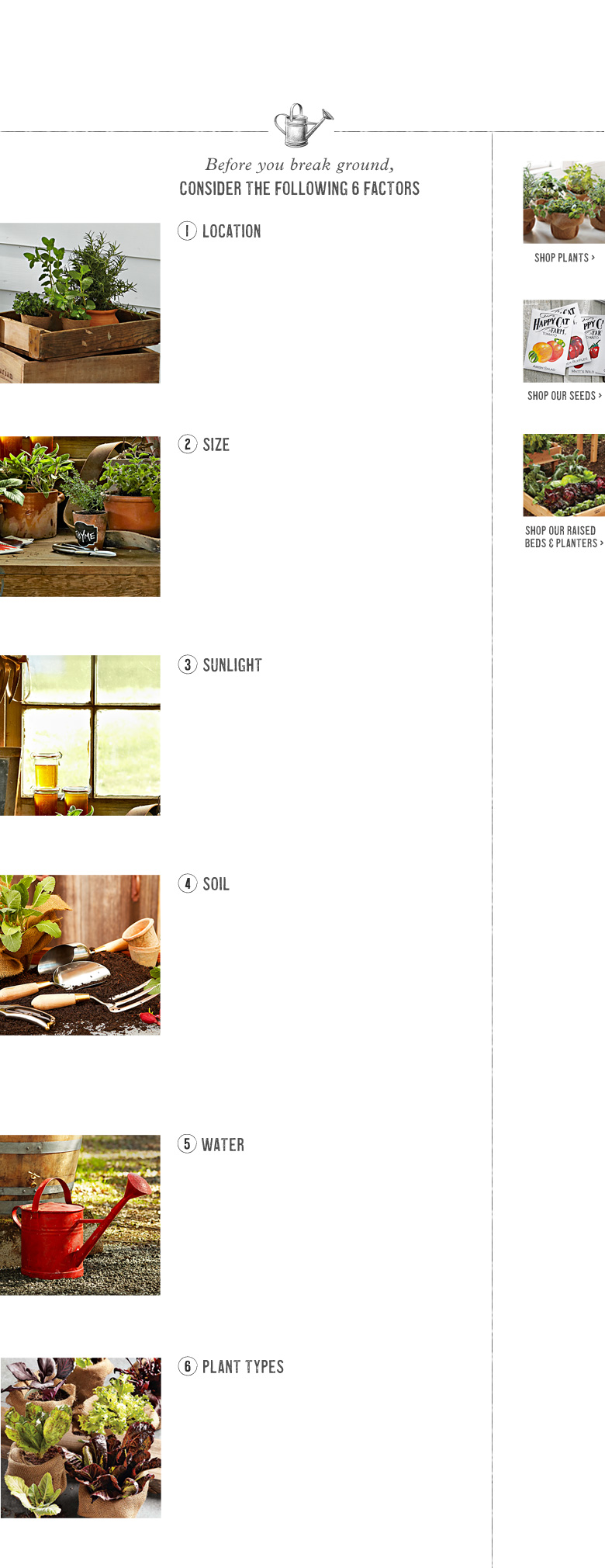

Meals made with homegrown herbs, vegetables and fruits are more flavorful and nutritious than those using store-bought produce because you harvest the produce at its peak and it doesn't need to travel far to get to the table. By growing your own herbs, vegetables and fruits organically, you can also be confident that no chemicals or pesticides have been added to your food.
An edible garden doesn't need to be large to produce plenty of nourishing ingredients for your table. Start small with a few basics, and as the fruits or vegetables begin to thrive, you can use what you learn to make changes and additions to your plot.
Choose a spot close to the kitchen if possible, especially for growing herbs, so you can easily snip and harvest for cooking. If there is no nearby space for a ground plot or raised beds, containers set on a patio or deck are a good option. Herbs and some small plants can also be grown in pots on a sunny windowsill.
If you're planting your first edible garden, it's best to start small. Once you begin to water, weed and harvest your plants, you'll have a better sense of what size garden will be optimal for your culinary interests and lifestyle.
For a one-sided garden, aim for a planting area with a depth of about three feet, which is the average adult reach. This will allow you to tend your plants and pick fruits and vegetables without stepping on the soil.
The length of your garden will depend on available space and preference, but if you have adequate room, consider a two-sided garden plot with a four-to-six-foot expanse. Using a plant-a-gram will help you maximize a small space and anticipate your harvest.
Almost all herbs, vegetables and fruits require significant sunlight to flourish. To determine the best location for your garden, note the position of the sun as it moves over your yard during the day. Select a spot that receives a minimum of four hours of direct midday sun. A spot near a wall that reflects sunlight or holds heat can also be helpful. Pay attention to shadows from buildings and large trees and to how the light changes from season to season.
In general, herbs and plants that produce edible fruit (basil, tomatoes, peppers, blueberries) need maximum light, while vegetables with edible leaves (lettuce, spinach, chard and other leafy greens) do better with less sunlight; some can even handle partial shade.
Take note of how water runs through the property and where it settles. For optimum plant health and productivity, choose a level spot that allows the water to drain from the soil naturally and avoid locations in which water pools after a rain. If drainage is not ideal in your yard, a raised bed is a smart solution.
To ensure a bountiful harvest, almost all soil requires amending to increase its organic makeup and provide roots with oxygen and nutrients. In heavy, compacted soil, water runs off without soaking in and plants spread out shallowly rather than growing down deep. Supplement such soil with an organic growing mix and incorporate it well for aeration.
Mixing compost into the soil helps achieve the optimum pH levels for nutrient production and primes it with beneficial microorganisms. Home- made compost, if you have it, is ideal for an edible garden, but commercial amendments also work well.
For ease in caring for your garden, position it near a faucet attached to a short length of food-grade hose. Installing a drip-irrigation system is an effective water and time-saving option that doesn't require a large investment. Rain barrels offer an eco-friendly watering option and can be placed close to a garden as a supplemental water supply.
Morning is the best time to water plants so they begin the day well hydrated. Gardens always benefit from a rain shower, but when you are watering, avoid wetting the foliage. Instead, apply the water directly to the soil. A thorough soaking will reach the roots deep in the ground, helping plants tolerate high temperatures and other environmental challenges.
Starting with a few vegetables and herbs will help you focus your efforts and give you confidence as your garden grows. When planning your edible garden, take into consideration which herbs, vegetables and fruits you buy regularly and enjoy cooking. You might grow them yourself instead. It can also be fun to choose a few unfamiliar ones to experiment with.
Consider which plants are both appropriate for the size of your garden and your hardiness zone. With a bit of planning, sowing your own seeds is a fun and cost-effective way of introducing a wide variety of foods in your edible garden. Alternatively, planting young, already established plants can save time and ensure that you don't miss out on any growing seasons.








